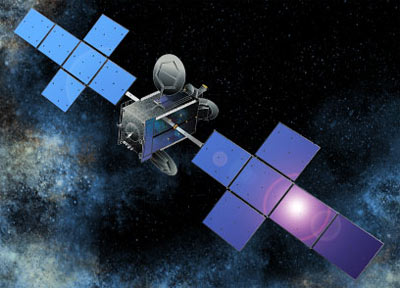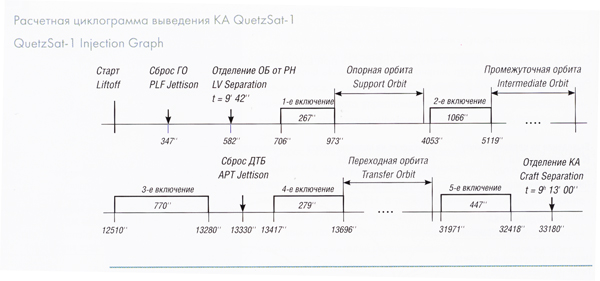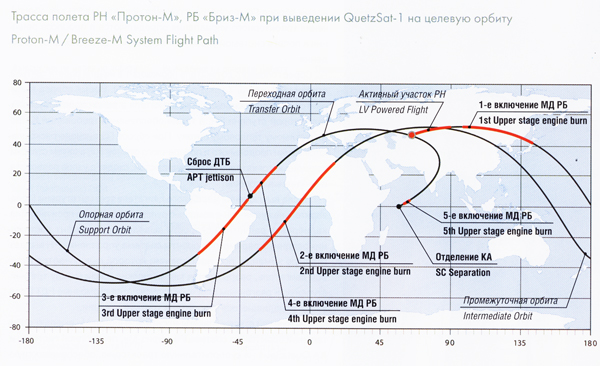The first commercial flight of the Proton rocket since the mid-August failure will take place later today. The Proton-M/Briz-M rocket will launch the QuetzSat-1 satellite for SES S.A. of Luxembourg.
QuetzSat-1, part of the 45+ satellite fleet of SES, will be located at the 77 degree west orbital location at which the Mexican Government has granted the DTH frequency rights to QuetzSat S. de R.L. de C.V., a Mexican-controlled company comprised of SES and Mexican investors. The spacecraft will provide coverage over Mexico, North America and Central America. The spacecraft is fully contracted to EchoStar Corporation and will be used in part by Dish Mexico, an EchoStar joint venture, for DTH services in Mexico and to a subsidiary of DISH Network for use in connection with its U.S. DTH business.
The QuetzSat-1 mission will be the 5th Proton launch of 2011 and the 368th Proton flight overall.
This will be the third commercial mission of the year for ILS and the 67th ILS Proton mission since the Proton April 1996 first commercial flight.
This will also be the 19th SES satellite launched with Proton. In addition, the QuetzSat-1 will be the 18th Space Systems/Loral satellite launched on Proton.





Launch location:
Baikonur Launch pad no. 200/39 46° 2'23.85"N, 63° 1'54.98"E
Launch dates and times:
{colsp=6}Launch times
Time Zone |
{colsp=6}
Live Coverage Of The Launch:
PAYLOAD
QuetzSat-1 communication satellite:


Mission Summary
Procured by SES, QuetzSat-1 is a high-power communications satellite with coverage of Mexico, North America, and Central America, which is fully contracted to a subsidiary of EchoStar Corporation and will be used in part by Dish Mexico, an EchoStar joint venture, for Direct-To-Home (DTH) services in Mexico. The Ku-band satellite is scheduled for launch in 2011 and is designed to provide service for 15 years or more. Based on the flight-proven SS/L 1300 satellite platform, which provides flexibility for a broad range of applications, the satellite will be located at 77 degrees West.
{colsp=2}Summary
Parameter | Value
Characteristics|
|

Launch Vehicle:
{colsp=2}Characteristics
 |
|
{colsp=2}

The vehicle's reliability statistics according to http://www.spacelaunchreport.com/log2011.html#rate:
QuetzSat-1 Ascent Profile
The Proton-M first three stages place the orbital unit (OU), which consists of a Breeze-M upper stage, adapter system and QuetzSat-1, into 51.5° inclination suborbital trajectory.
Proton-M powered flight lasts 582 seconds. The OU powered flight begins at the moment of the third stage separation.

Immediately after the separation of the third stage booster, the Breeze-M stability engines start, damping the angular velocities of the third stage separation and then providing orbital unit orientation and stability during coast flight along a suborbital trajectory to await the first burn. The upper stage follows a five-burn injection profile.


QuetzSat-1 Ascent Timeline
Event|Time rel lift-off|Time UTC|Comment
Ignition Start Sequence|-00:00:02.5|18:31:57.5 (Sep 29th)|
Stage 1 Ignition (40% thrust)|-00:00:01.75|18:31:58.25|
Command Stage 1 (100% thrust)|-00:00:00.9|18:31:59.1|
Maximum Dynamic Pressure|00:01:02|18:32:02|
1st/2nd Stage Separation|00:02:00|18:33:00|
2nd/3rd Stage Separation|00:05:27|18:36:27|
Payload Fairing Separation|00:05:47|18:36:47|
3rd Stage/Breeze M Separation|00:09:42|18:41:42|
1st Burn Ignition|00:11:46|18:43:46|
1st Burn Shutdown|00:16:13|18:48:13|1st Burn's Duration 00:04:27
2nd Burn Ignition|01:07:33|19:39:33|
2nd Burn Shutdown|01:25:19|19:57:19|2nd Burn's Duration 00:17:46
3rd Burn Ignition|03:28:30|22:00:30|
3rd Burn Shutdown|03:41:20|22:13:20|3rd Burn's Duration 00:12:50
APT Jettison|03:42:10|22:14:10|
4th Burn Ignition|03:43:37|22:15:37|
4th Burn Shutdown|03:48:16|22:20:16|4th Burn's Duration 00:04:39
5th Burn Ignition|08:52:51|03:24:51(Sep 30th)|
5th Burn Shutdown|09:00:18|03:32:18|5th Burn's Duration 00:07:27
Spacecraft Separation|09:13:00|03:45:00|
Weather forecast for Baikonur, Kazakhstan on September 29, 2011 (7 p.m.)
Time|Temps|Wind|Chill|Dew Point|Relative Humidity|Precip|Snow|Clouds|Visibility|Wind|Weather
7 PM|15°C|15°C|15°C|-2°C|29%|0%|0%|0%|10KM|SSE 0 m/s|
 Clear
Clear
Sunrise/Sunset and associated twilight times for Baikonur on Thursday, September 29, 2011
Times are local.
Event|Time
Astronomical twilight begins|06 : 03
Nautical twilight begins|06 : 38
Civil twilight begins|07 : 13
Sunrise|07 : 41
Transit (sun is at its highest)|13 : 47
Sunset|19 : 34
Civil twilight ends|20 : 02
Nautical twilight ends|20 : 37
Astronomical twilight ends|21 : 12
References
http://www.federalspace.ru
http://tvroscosmos.ru
http://www.khrunichev.ru
http://www.ilslaunch.com
http://tihiy.fromru.com/Rn/RN_Proton.htm
http://en.ses.com
http://www.ssloral.com/html/satexp/quetzsat1.html
http://www.dish.com.mx/
http://www.tsenki.com
http://forum.nasaspaceflight.com
http://www.novosti-kosmonavtiki.ru
http://www.spacelaunchreport.com
http://www.intellicast.com/Local/Forecast.aspx
http://www.good-stuff.co.uk/suntimes/sunmap.php
---------- Post added at 23:25 ---------- Previous post was at 23:16 ----------
Pictures and Videos:








QuetzSat-1, part of the 45+ satellite fleet of SES, will be located at the 77 degree west orbital location at which the Mexican Government has granted the DTH frequency rights to QuetzSat S. de R.L. de C.V., a Mexican-controlled company comprised of SES and Mexican investors. The spacecraft will provide coverage over Mexico, North America and Central America. The spacecraft is fully contracted to EchoStar Corporation and will be used in part by Dish Mexico, an EchoStar joint venture, for DTH services in Mexico and to a subsidiary of DISH Network for use in connection with its U.S. DTH business.
The QuetzSat-1 mission will be the 5th Proton launch of 2011 and the 368th Proton flight overall.
This will be the third commercial mission of the year for ILS and the 67th ILS Proton mission since the Proton April 1996 first commercial flight.
This will also be the 19th SES satellite launched with Proton. In addition, the QuetzSat-1 will be the 18th Space Systems/Loral satellite launched on Proton.





Launch location:
Baikonur Launch pad no. 200/39 46° 2'23.85"N, 63° 1'54.98"E
Launch dates and times:
Time Zone |
Baikonur / UTC+6
|
Luxembourg / CEST
|
Universal / UTC
|
Washington / EDT
|
Los Angeles / PDT
Launch time (Primary):
|
00:32:00
|
20:32:00
|
18:32:00
|
14:32:00
|
11:32:00
on:
|
Sep. 30, 2011
|
Sep. 29, 2011
|
Sep. 29, 2011
|
Sep. 29, 2011
|
Sep. 29, 2011
{colsp=6}
[highlight][eventTimer]2011-09-29 18:32:00?before|after;%dd% Days %hh% Hours %mm% Minutes %ss% Seconds %c%[/eventTimer] QuetzSat-1 Launch[/highlight]
Live Coverage Of The Launch:
- International Launch Services: http://quetzsat1.imgondemand.com (begins at 20 minutes before lift-off)
- TSENKI Video Streams: http://www.tv-tsenki.com/livechoose.php
- Khrunichev COOPI (login: ? password: ?): http://coopi.khrunichev.ru/main.php?id=200
- Owners of PDA can watch the launch in test mode on: http://www.space-center.ru
PAYLOAD
QuetzSat-1 communication satellite:


Mission Summary
Procured by SES, QuetzSat-1 is a high-power communications satellite with coverage of Mexico, North America, and Central America, which is fully contracted to a subsidiary of EchoStar Corporation and will be used in part by Dish Mexico, an EchoStar joint venture, for Direct-To-Home (DTH) services in Mexico. The Ku-band satellite is scheduled for launch in 2011 and is designed to provide service for 15 years or more. Based on the flight-proven SS/L 1300 satellite platform, which provides flexibility for a broad range of applications, the satellite will be located at 77 degrees West.
Parameter | Value
Working Orbit:
|
GEO
Orbital Location:
|
77° West
Coverage:
|
Mexico, North America, Central America
ApA at separation:
|
35786 km
PeA at separation:
|
5983 km
Inc at separation:
|
18.6°QuetzSat-1
Customer:
|- SES S.A.

Prime contractor:
|- Space Systems / Loral

Platform:
|- Space Service Loral LS-1300S
Mass at Separation:
|- 5514 kg
Dry Mass:
|- ?
Stabilization:
|- 3 axis stabilized
Dimensions (stowed):
|- ?
Batteries:
|- ?
Navigation Payload:
|- 32 Ku-band transponders
Life time:
|- 15 years
|

Launch Vehicle:

Proton-M / Briz-M
Prime contractor:
|- Khrunichev Space Centre

GRAU Index:
|- 8K82KM
Height:
| 58.2 m with upper stage and payload fairingDiameter:
| max 7.4 mLiftoff mass:
| 705 metric tonnesPayload mass:
| ~22 tonnes at LEO1st stage:
|- 6 X RD-275 engines
- Empty 30.6 tonnes
- Propellants 419.41 tonnes (UDMH and NTO)
- Thrust in vacuum 1069.8 tonnes of force
- Thrust at sea level 971.4 tonnes of force
2nd stage:
|- 1 X RD-0211 engine 3 X RD-0210 engines
- Empty 11.4 tonnes
- Propellants 156.113 tonnes (UDMH and NTO)
- Thrust in vacuum 237.4 tonnes of force
3rd stage:
|- 1 X RD-0213 engine & 1 X RD-0214 vernier engine
- Empty 3.7 tonnes
- Propellants 46.562 tonnes (UDMH and NTO)
- Thrust in vacuum 59.36 (core) + 3.15 (vernier) tonnes of force
Upper Stage:
|

- GRAU Index: 14S43
- Common Name: Briz-M
- Designer & Manufacturer: Khrunichev Space Centre
- Dimensions: Length 2.654 m, Diameter 4 m
- Empty Mass 2.2 tonnes
- Propellants 6 660 kg UDMH + 13 260 kg N2O4
- Flight time: no less than 24 hours
- Main Engine: 1 X 14D30
- Thrust in vacuum 2.0 tonnes of force
- ISP 328.6 s
- Main engine restarts: up to 8 times
- Precision Manoeuvering Engines: 4 X 11D458
- Thrust in vacuum 400 N each
- ISP 252 s
- RCS Engines: 12 X 17D58E
- Thrust in vacuum 13.3 N each
- ISP 274 s
Payload Fairing:
|- Diameter 4.35 m
- Length 11.6 m
The vehicle's reliability statistics according to http://www.spacelaunchreport.com/log2011.html#rate:
Code:
================================================================
Vehicle Successes/Tries Realzd Pred Consc. Last Dates
Rate Rate* Succes Fail
================================================================
Proton-M/Briz-M 43 47 .91 .90 1 08/17/11 2001-QuetzSat-1 Ascent Profile
The Proton-M first three stages place the orbital unit (OU), which consists of a Breeze-M upper stage, adapter system and QuetzSat-1, into 51.5° inclination suborbital trajectory.
Proton-M powered flight lasts 582 seconds. The OU powered flight begins at the moment of the third stage separation.

Immediately after the separation of the third stage booster, the Breeze-M stability engines start, damping the angular velocities of the third stage separation and then providing orbital unit orientation and stability during coast flight along a suborbital trajectory to await the first burn. The upper stage follows a five-burn injection profile.


QuetzSat-1 Ascent Timeline
Ignition Start Sequence|-00:00:02.5|18:31:57.5 (Sep 29th)|
Stage 1 Ignition (40% thrust)|-00:00:01.75|18:31:58.25|
Command Stage 1 (100% thrust)|-00:00:00.9|18:31:59.1|
Maximum Dynamic Pressure|00:01:02|18:32:02|
1st/2nd Stage Separation|00:02:00|18:33:00|
2nd/3rd Stage Separation|00:05:27|18:36:27|
Payload Fairing Separation|00:05:47|18:36:47|
3rd Stage/Breeze M Separation|00:09:42|18:41:42|
1st Burn Ignition|00:11:46|18:43:46|
1st Burn Shutdown|00:16:13|18:48:13|1st Burn's Duration 00:04:27
2nd Burn Ignition|01:07:33|19:39:33|
2nd Burn Shutdown|01:25:19|19:57:19|2nd Burn's Duration 00:17:46
3rd Burn Ignition|03:28:30|22:00:30|
3rd Burn Shutdown|03:41:20|22:13:20|3rd Burn's Duration 00:12:50
APT Jettison|03:42:10|22:14:10|
4th Burn Ignition|03:43:37|22:15:37|
4th Burn Shutdown|03:48:16|22:20:16|4th Burn's Duration 00:04:39
5th Burn Ignition|08:52:51|03:24:51(Sep 30th)|
5th Burn Shutdown|09:00:18|03:32:18|5th Burn's Duration 00:07:27
Spacecraft Separation|09:13:00|03:45:00|
Weather forecast for Baikonur, Kazakhstan on September 29, 2011 (7 p.m.)
7 PM|15°C|15°C|15°C|-2°C|29%|0%|0%|0%|10KM|SSE 0 m/s|

Sunrise/Sunset and associated twilight times for Baikonur on Thursday, September 29, 2011
Times are local.
Astronomical twilight begins|06 : 03
Nautical twilight begins|06 : 38
Civil twilight begins|07 : 13
Sunrise|07 : 41
Transit (sun is at its highest)|13 : 47
Sunset|19 : 34
Civil twilight ends|20 : 02
Nautical twilight ends|20 : 37
Astronomical twilight ends|21 : 12
References
http://www.federalspace.ru
http://tvroscosmos.ru
http://www.khrunichev.ru
http://www.ilslaunch.com
http://tihiy.fromru.com/Rn/RN_Proton.htm
http://en.ses.com
http://www.ssloral.com/html/satexp/quetzsat1.html
http://www.dish.com.mx/
http://www.tsenki.com
http://forum.nasaspaceflight.com
http://www.novosti-kosmonavtiki.ru
http://www.spacelaunchreport.com
http://www.intellicast.com/Local/Forecast.aspx
http://www.good-stuff.co.uk/suntimes/sunmap.php
---------- Post added at 23:25 ---------- Previous post was at 23:16 ----------
Pictures and Videos:







Last edited:




